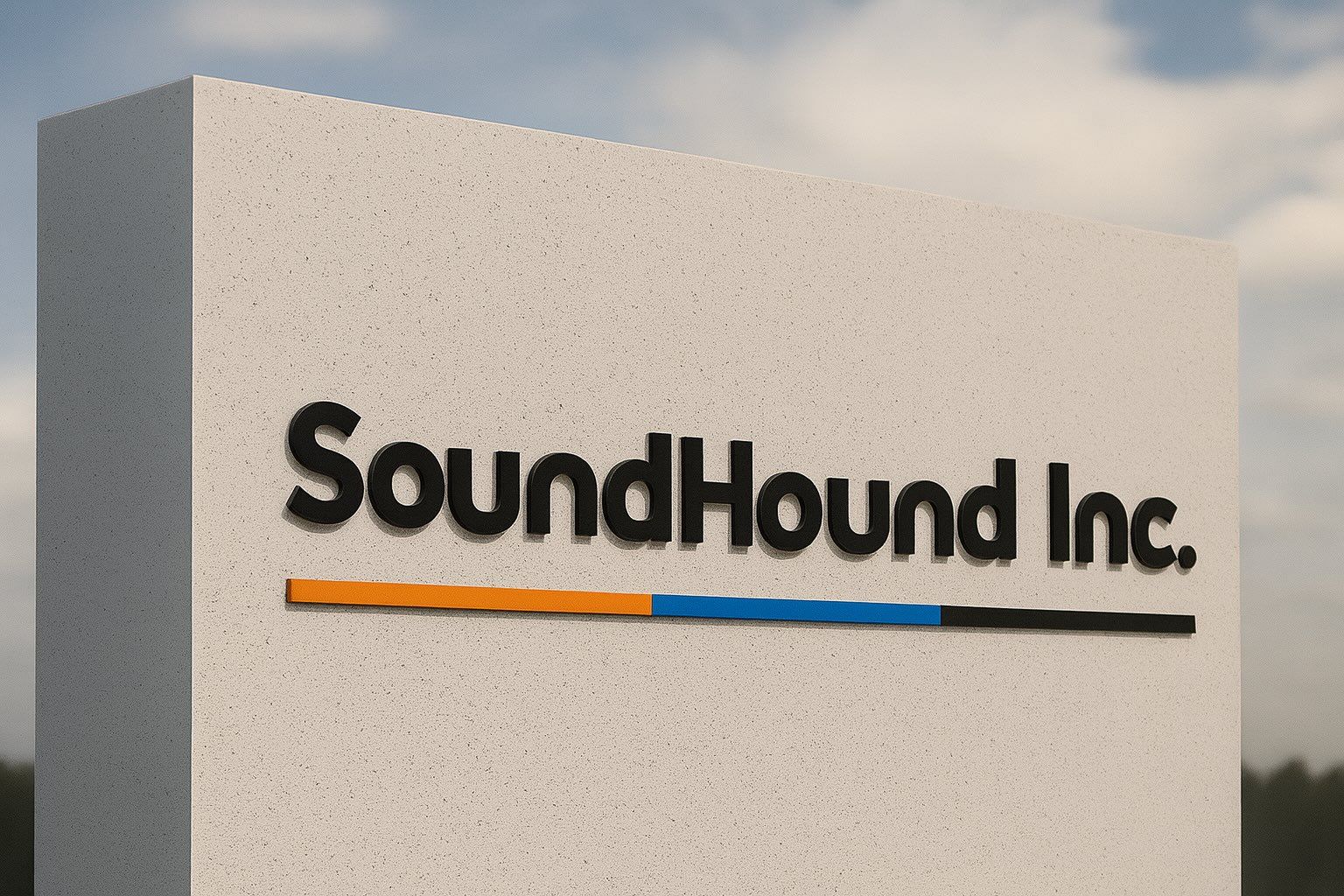- Insider sale sparks drop: SoundHound AI (SOUN) shares fell sharply (~7–10%) on Oct. 17, dipping to around $18.8 after the company’s CFO Nitesh Sharan sold ~$1.28 million worth of stock (60,376 shares at ~$21.21 each) [1]. The disclosure spooked investors; by midday, SOUN hovered near $18.86, down ~10% on the day [2].
- Huge 2025 gains: Despite the pullback, SOUN remains up roughly +240% year-to-date amid a broader AI stock boom. The price recently hit ~$20–21 this week – its highest level since early 2025 – on unusually heavy trading volume [3].
- Explosive growth: SoundHound’s Q2 2025 revenue jumped +217% year-over-year to a record $42.7 million, beating analyst expectations by ~30%. The company also raised its full-year 2025 sales forecast to $160–178 million (about 2× 2024’s revenue) on that momentum [4].
- New deals & recognition: Big partnerships are validating SoundHound’s tech. Red Lobster is rolling out SoundHound’s voice AI to automate phone ordering across all its restaurants, and French insurer Apivia (part of AEMA Group) is deploying SoundHound’s Amelia 7 intelligent agents in its contact centers [5]. Industry analysts have taken note: IDC’s latest report named SoundHound a Leader in conversational AI software [6].
- Lofty valuation & swings: The stock’s valuation and volatility are striking. At ~$20 per share, SoundHound commands an ~$8 billion market cap – over 40× its trailing sales [7]. Its 52-week price range ($4.8 – $25) reflects huge swings, with frequent 5–10% daily moves [8]. Short interest remains elevated (~30% of the float) [9], indicating many are betting against the stock (fuel for potential short squeezes).
- Profitability concerns: SoundHound is still unprofitable, posting a Q2 net loss of $0.19 per share (GAAP) despite surging revenue [10]. Executives have also been cashing out – insiders including the CEO sold ~725,000 shares (~$12.7 M worth) during the rally’s climb [11].
- Analyst caution: Wall Street’s take is mixed. The consensus rating is “Moderate Buy,” but analysts’ average 12-month target (~$14–15) sits well below the current price [12]. Some optimists hiked targets into the high teens after strong results, citing SoundHound’s “durable growth potential” [13]. Yet others urge caution: Zacks Investment Research keeps a Hold rating, noting the company “has struggled to achieve profitability” despite rapid growth [14].
Stock Slides After CFO’s Share Sale
SoundHound AI stock sank on Friday after news of insider selling, undercutting some of the recent euphoria. The company’s Chief Financial Officer, Nitesh Sharan, disclosed he sold 60,376 SoundHound shares at an average ~$21.21 (a ~$1.28 million transaction) [15]. The sale, executed under a pre-arranged 10b5-1 trading plan, reduced the CFO’s direct stake by about 3.3% [16]. The market reacted swiftly: SOUN fell ~6.9% in morning trading on Oct. 17 following the disclosure, and by afternoon it was trading around $18.80, roughly 9–10% below the prior day’s close [17] [18].
The timing of Sharan’s sale coincided with a broader market pullback, which may have amplified the stock’s decline. Major indexes were down on Oct. 17 amid investor jitters over regional bank troubles and trade tensions, creating a general “risk-off” mood [19]. In that context, SoundHound’s insider sale news hit an already fragile market tape, exacerbating the sell-off. The stock eventually closed the day deep in the red, marking one of its sharpest single-day drops in recent months.
A 240% Rally Fueled by AI Hype
This sudden dip comes on the heels of a remarkable run-up for SoundHound AI in 2025. Even after Friday’s slide, SOUN shares have surged about 240% year-to-date [20], propelled by intense investor enthusiasm for artificial intelligence plays. Earlier this week, the stock touched roughly $21 per share – its highest level since January – amid a flurry of upbeat news and trading frenzy [21]. For instance, on October 13 the stock spiked around 10% intraday, with over 50 million shares changing hands (far above normal volume) [22]. Such gains have made SoundHound one of 2025’s standout performers, riding the wave of AI mania that has lifted many next-gen tech names.
Multiple catalysts have ignited SoundHound’s rally. In late September, industry research firm IDC published a report naming SoundHound as a Leader in the conversational AI software market [23] – a credibility boost for the company’s platform. Around the same time, SoundHound announced a series of high-profile customer wins. Notably, Red Lobster unveiled a nationwide partnership to use SoundHound’s voice AI for automating phone order intake across all its U.S. restaurants [24]. And in the insurance sector, France’s Apivia Courtage (part of AEMA Group) is rolling out SoundHound’s new Amelia 7 AI agent in its contact centers after a pilot program showed the AI could handle complex customer calls and even boosted productivity by ~20% [25]. These deals showcase real-world uptake of SoundHound’s technology, reinforcing investors’ confidence in the company’s growth story [26].
Another key driver of enthusiasm was SoundHound’s blowout financial results over the summer. In August, the company’s Q2 2025 earnings report handily beat expectations: revenue hit an all-time high of $42.7 million for the quarter (+217% year-on-year), about 30% above analyst forecasts [27]. Off the back of that performance, management raised its full-year 2025 revenue guidance to $160–178 million (nearly double the $84.6 M booked in 2024) [28]. Such torrid growth – coupled with upbeat remarks that SoundHound expects 50%+ annual organic growth “for the foreseeable future” – emboldened the bulls. The company also touts a robust sales pipeline: its backlog of booked business exceeds $1.2 billion (multi-year contracts, over 7× current annual revenue) [29]. That huge backlog, along with a strong balance sheet (~$230 M cash on hand and no debt as of mid-2025) [30], suggests SoundHound has significant revenue locked in and room to fund its expansion. All these factors – big-name partnerships, analyst accolades, and rapid revenue growth – have helped propel SoundHound’s stock to stratospheric levels over the past year.
Valuation and Volatility Pose Risks
For all its successes, SoundHound’s stock comes with high volatility and a frothy valuation that give some investors pause. At around $19–20 per share, the company commands roughly an $8 billion market cap – an eye-popping valuation of about 40× trailing 12-month sales [31] (and ~25× forward revenue, based on its own 2025 guidance). That kind of price-to-sales multiple is reminiscent of early-stage high-growth software darlings, and it leaves little room for error. The trading history reflects the volatility: SoundHound’s stock has ranged from about $4.80 to $24.98 in the past 52 weeks [32], and daily swings of 5–10% (or more) have not been uncommon [33]. In fact, SOUN has notched nearly a hundred daily moves greater than ±5% in the last year [34] – a rollercoaster ride that underscores the speculative fervor around this name.
One contributor to the turbulence is the large contingent of short sellers targeting SoundHound. Roughly 30% of SOUN’s float has been sold short [35], a very high level of short interest that can fuel exaggerated moves in both directions. When sentiment is bullish, heavy short interest can spark short squeezes (as bears scramble to cover positions, driving the price higher). Conversely, any negative news can be a trigger for shorts to pile on, accelerating declines. This dynamic has likely played a role in SoundHound’s sharp surges and drops. In short, the stock’s meteoric rise has been accompanied by equally outsized risk – investors in SOUN are no strangers to sudden whiplash-inducing price moves.
Insiders cashing out have added to the caution. Amid the stock’s 2025 climb, some company executives seized the opportunity to trim their holdings. Over the last quarter, SoundHound insiders – including CEO Keyvan Mohajer – sold roughly 725,000 shares (around $12.7 million worth) as the stock price surged [36]. The CFO’s sale this week is part of that broader pattern (though planned in advance). To be clear, moderate insider selling at high prices isn’t unusual for a young tech firm, but it can signal that management sees the current valuation as at least partially warranted to monetize. Meanwhile, profitability remains elusive for SoundHound. Despite its rapid revenue growth, the company is still operating in the red. It reported a net loss of $0.19 per share (GAAP) in Q2 [37], and only a slim $0.03 loss on an adjusted (non-GAAP) basis. Gross margins have been improving (close to 58% non-GAAP in Q2) but heavy investments and recent acquisitions have kept GAAP margins depressed [38]. SoundHound’s leadership maintains that scaling revenue will eventually flip the bottom line to positive – executives have stated goals of reaching break-even by late 2025 [39]. Still, until the company can prove it can turn blockbuster sales growth into actual profits, skepticism will linger.
On the technical front, SoundHound’s stock remains in an uptrend despite the latest pullback. Even after dropping back to the high-teens, SOUN is trading well above key moving averages – recently around 30% above its 50-day moving average (~$14.80) and far above the 200-day (~$11.60) [40]. Chart analysts note that the stock’s breakout above the ~$18 level this month was significant: there is little obvious overhead resistance until the prior highs around $24–25 [41]. In other words, if positive momentum resumes, the stock could have room to run further before encountering technical selling pressure. However, at current valuations the bar is very high. With the stock pricing in years of growth (30× this year’s sales), any stumble – whether a growth slowdown, earnings miss, or shift in market sentiment – could trigger a swift sell-off [42]. The same MarketBeat analysis that outlined bullish catalysts also cautioned that SoundHound’s lofty sales multiple makes it vulnerable to “any disappointment” [43]. In short, the stock’s near-term fate may depend on continued flawless execution (and a continued risk-on market for AI names) to justify its rich price.
Analyst Outlook and Targets
Wall Street analysts have a cautiously optimistic but measured view of SoundHound AI. According to recent surveys, the stock carries a consensus “Moderate Buy” rating, with roughly 5 analysts rating it a Buy, 4 Hold, and 1 Sell [44]. That said, price targets tell a more guarded story. The average 12-month target price for SOUN is only about $14–15 per share [45] – well below the stock’s current trading range, suggesting analysts collectively see valuation risk. In fact, at around $20, SoundHound is trading above even the highest targets of many covering firms. In just the last few weeks, some analysts did boost their projections on the heels of SoundHound’s strong Q2 results and expanding deals: for example, Ladenburg Thalmann lifted its target to $16, and D.A. Davidson to $17 [46]. But those revised targets still imply the stock could fall from current levels. In other words, even bullish analysts aren’t forecasting huge upside from here after the stock’s 240%+ run – rather, they’re mostly baking in the possibility of a pullback or consolidation.
Analysts generally praise SoundHound’s technology and growth potential, while flagging the uncertainties. Oppenheimer, which initiated coverage on SOUN in September, lauded the company’s “technology advantage” in voice AI and its “durable growth potential,” yet started with a neutral Perform rating due to formidable competition and the long road to consistent profitability [47]. As Oppenheimer’s analyst put it, SoundHound is a leader in a attractive niche but faces “formidable competition ahead” from much larger players [48]. On the more bearish end of the spectrum, independent rater Weiss Ratings recently slapped SoundHound with a Sell grade (D-), and Zacks Investment Research continues to rank it at Hold, noting the company “has struggled to achieve profitability” despite its rapid revenue growth [49]. These cautious views underline that not everyone on the Street is convinced the current valuation is justified by SoundHound’s outlook.
Still, many analysts acknowledge the long-term opportunity if SoundHound executes well. The addressable market for voice AI is enormous – by some estimates $50+ billion in coming years [50] – spanning everything from smart assistants and customer service bots to in-car voice interfaces. If SoundHound can continue converting its $1B+ backlog into revenue and sustain high double-digit growth, a number of observers believe it could eventually “grow into” its valuation [51] [52]. “The AI boom has put SoundHound on the radar as a potential long-term winner” in voice technology, one analyst noted [53]. Bulls argue that as a first-mover focused exclusively on voice AI, SoundHound could capture a meaningful slice of that $50B pie over time. However, skeptics counter that intense competition and execution risk loom large – as Zacks analysts emphasize, patience is warranted given that SoundHound “has [so far] struggled to achieve profitability” and must prove it can eventually turn a profit from its surging sales [54].
Competitive Landscape and Industry Trends
SoundHound operates in an increasingly crowded AI arena – one dominated by tech giants with deep pockets. Major players like Google, Amazon, Apple, Microsoft, and Meta are all investing heavily in voice-enabled AI and digital assistants. Unlike those consumer-focused behemoths (think Alexa, Siri, Google Assistant), SoundHound has carved out a different approach: it positions itself as an independent, business-to-business (B2B) voice AI provider. Rather than competing in the smart speaker or smartphone assistant market, SoundHound sells its voice recognition and conversational AI solutions to enterprises – powering other companies’ apps, call centers, vehicles, and devices [55]. This strategy means SoundHound can collaborate with a broad range of industry partners without directly going head-to-head with Big Tech’s consumer platforms. Indeed, SoundHound’s tech is already embedded in products from automakers (Hyundai, Kia, Stellantis) to restaurant chains (e.g. drive-thru ordering for fast-food brands) [56]. Many enterprise clients prefer an independent voice AI specialist that can customize solutions and ensure data privacy, rather than relying on big consumer-tech providers.
That said, the competitive threat from the giants is never far off. Companies like Google and Amazon continuously improve their voice AI models and could encroach on markets that SoundHound targets [57]. Microsoft’s acquisition of Nuance (a leading speech recognition firm) shows large players are keen on enterprise voice tech as well. To maintain an edge, SoundHound is leaning on its proprietary technology – notably its advanced speech recognition engine and natural language understanding platform. The company claims its new Polaris AI model offers superior accuracy, boasting 30–40% better speech transcription than OpenAI’s Whisper or Google’s voice AI in internal tests [58]. SoundHound also integrates generative AI and large language models (e.g. its Amelia conversational agents can “listen, reason, and act” to complete complex tasks) [59]. These capabilities earned SoundHound top marks in the recent IDC MarketScape, which cited its low-latency, multi-language understanding as a differentiator [60].
Going forward, SoundHound’s challenge will be to keep innovating faster than the industry titans. Its focused, flexible platform gives it a shot at a “lasting competitive edge” in certain sectors – especially in domains like automotive, hospitality, and finance that value customization and data control [61]. But as one analyst warned, as Big Tech refines its own AI assistants, smaller players like SoundHound “will face an uphill battle” to maintain technical superiority [62]. In essence, SoundHound must leverage its head start and niche strategy before the window closes. Meanwhile, the overall AI market trend remains a double-edged sword: the same AI gold rush that has boosted SoundHound’s profile also means rising competition and sky-high expectations across the sector.
Bottom Line: SoundHound AI’s stock epitomizes both the promise and peril of the current AI frenzy. On one hand, the company is riding a wave of excitement – delivering explosive growth, inking major partnerships, and emerging as a recognized leader in voice tech [63]. This has put SoundHound front-and-center as a pure-play beneficiary of the AI boom, with bulls betting it could be a long-term winner in the space [64]. On the other hand, the stock’s meteoric rise and rich valuation make it vulnerable. Deep-pocketed rivals are circling, insiders are cashing in, and profitability is still on the horizon. Investors will be watching closely to see if SoundHound can continue living up to the hype and execute on its bold ambitions – or if gravity will eventually bring this high-flyer back down to earth [65].
Sources: Official SoundHound investor releases and news (partnership announcements, financial results) [66] [67]; TS2.tech analysis and market data [68] [69]; IndexBox/Yahoo Finance news [70] [71]; MarketBeat and TipRanks analyst reports [72] [73]; IDC industry research on conversational AI [74].
References
1. www.indexbox.io, 2. www.indexbox.io, 3. ts2.tech, 4. ts2.tech, 5. ts2.tech, 6. ts2.tech, 7. ts2.tech, 8. ts2.tech, 9. ts2.tech, 10. ts2.tech, 11. ts2.tech, 12. ts2.tech, 13. ts2.tech, 14. ts2.tech, 15. www.indexbox.io, 16. www.indexbox.io, 17. www.indexbox.io, 18. www.indexbox.io, 19. www.indexbox.io, 20. ts2.tech, 21. ts2.tech, 22. ts2.tech, 23. ts2.tech, 24. investors.soundhound.com, 25. www.globenewswire.com, 26. ts2.tech, 27. ts2.tech, 28. ts2.tech, 29. ts2.tech, 30. ts2.tech, 31. ts2.tech, 32. ts2.tech, 33. ts2.tech, 34. www.indexbox.io, 35. ts2.tech, 36. ts2.tech, 37. ts2.tech, 38. ts2.tech, 39. ts2.tech, 40. ts2.tech, 41. ts2.tech, 42. ts2.tech, 43. ts2.tech, 44. ts2.tech, 45. ts2.tech, 46. ts2.tech, 47. ts2.tech, 48. ts2.tech, 49. ts2.tech, 50. ts2.tech, 51. ts2.tech, 52. ts2.tech, 53. ts2.tech, 54. ts2.tech, 55. ts2.tech, 56. ts2.tech, 57. ts2.tech, 58. ts2.tech, 59. ts2.tech, 60. ts2.tech, 61. ts2.tech, 62. ts2.tech, 63. ts2.tech, 64. ts2.tech, 65. ts2.tech, 66. investors.soundhound.com, 67. www.globenewswire.com, 68. ts2.tech, 69. ts2.tech, 70. www.indexbox.io, 71. www.indexbox.io, 72. ts2.tech, 73. ts2.tech, 74. ts2.tech








